The global 5G millimeter wave RF transceiver market is valued at USD 1,039.4 million in 2025 and forecast to reach USD 2,393.7 million by 2035, recording an absolute increase of USD 1,354.3 million. This represents total growth of 130.2%, with the 5G millimeter wave RF transceiver market expected to expand at a CAGR of 8.7% and nearly 2.30X in size. Growth is supported by the scaling of 5G infrastructure, continuous innovation in semiconductor design, and diversified adoption across consumer, enterprise, and industrial ecosystems. Several key trends define the trajectory of this technology-driven market.
Network densification and telecom adoption is one of the strongest trends. Telecommunications operators are rapidly investing in small cell deployment and high-frequency spectrum utilization to meet the demand for ultra-fast data speeds. Millimeter wave RF transceivers are essential for achieving low-latency, high-capacity communication, particularly in densely populated urban areas. This drives steady demand from network equipment providers, creating a long-term structural growth base.
Integration in consumer electronics represents a parallel growth avenue. Smartphones, tablets, laptops, and wearables are increasingly incorporating millimeter wave transceivers to provide faster data transfer and immersive digital experiences. Virtual reality and augmented reality headsets also rely on this technology for seamless streaming and low-latency performance. With manufacturers competing on device connectivity as a differentiator, demand for compact, energy-efficient RF transceivers is expected to accelerate.
Industrial automation and enterprise applications reinforce the 5G millimeter wave RF transceiver market. Manufacturing, logistics, and smart infrastructure projects require high-bandwidth, low-latency communication for robotics, sensors, and automated control systems. Private 5G networks, particularly in factories and large-scale industrial sites, create new opportunities for millimeter wave adoption. This trend reflects a shift from consumer-led to enterprise-led demand, broadening the transceiver’s application base.
Advancements in semiconductor design and packaging are reshaping cost and performance benchmarks. Continuous progress in CMOS, SiGe, and GaAs processes enables higher efficiency, improved power output, and reduced heat dissipation. Antenna-in-package (AiP) and system-on-chip (SoC) integration are also emerging as key innovation areas, enabling smaller, more energy-efficient designs for mobile devices and IoT nodes. Such developments lower barriers to adoption while expanding functionality across diverse applications. Regional growth imbalances are also notable. Asia Pacific, led by China, South Korea, and Japan, is expected to dominate deployment, supported by strong telecom investments and consumer electronics manufacturing. North America follows with significant infrastructure rollouts, while Europe emphasizes enterprise and industrial applications. Emerging regions in Latin America and the Middle East will adopt gradually as infrastructure modernizes.
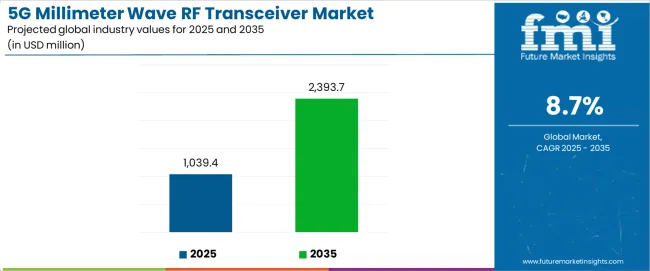
Between 2025 and 2030, the 5G millimeter wave RF transceiver market is projected to expand from USD 1,039.4 million to USD 1,451.1 million, resulting in a value increase of USD 411.7 million, which represents 30.4% of the total forecast growth for the decade. This phase of development will be shaped by increasing adoption of 5G infrastructure technologies, rising demand for high-frequency communication systems, and growing emphasis on enhanced wireless connectivity solutions with superior data transmission characteristics. Telecommunications service providers are expanding their network capabilities to address the growing demand for ultra-fast connectivity applications, enhanced mobile broadband services, and advanced industrial automation requirements.
| Metric | Value |
|---|---|
| Estimated Value (2025E) | USD 1,039.4 million |
| Forecast Value (2035F) | USD 2,393.7 million |
| Forecast CAGR (2025 to 2035) | 8.7% |
From 2030 to 2035, the 5G millimeter wave RF transceiver market is forecast to grow from USD 1,451.1 million to USD 2,393.7 million, adding another USD 942.6 million, which constitutes 69.6% of the overall ten-year expansion. This period is expected to be characterized by the expansion of advanced millimeter wave technologies, the integration of ai-powered signal processing systems, and the development of multi-band transceiver platforms with enhanced performance capabilities. The growing adoption of smart city initiatives will drive demand for 5G millimeter wave RF transceivers with superior connectivity features and compatibility with next-generation infrastructure systems across telecommunications networks.
Between 2020 and 2025, the 5G millimeter wave RF transceiver market experienced robust growth, driven by increasing demand for high-speed wireless communication technologies and growing recognition of millimeter wave solutions as essential components for efficient 5G network deployment across telecommunications, automotive, and consumer electronics applications. The 5G millimeter wave RF transceiver market developed as network operators recognized the potential for millimeter wave transceivers to deliver ultra-high bandwidth while enabling advanced connectivity features and supporting next-generation wireless protocols. Technological advancement in beamforming systems and multi-antenna architectures began emphasizing the critical importance of maintaining signal integrity and coverage optimization in diverse deployment environments.
Market expansion is being supported by the increasing global demand for high-speed wireless communication solutions and the corresponding need for advanced systems that can provide superior data transmission rates and connectivity efficiency while enabling reduced latency and enhanced network performance across various telecommunications and industrial automation applications. Modern network infrastructure and communication specialists are increasingly focused on implementing millimeter wave technologies that can deliver ultra-fast data speeds, support massive IoT deployments, and provide consistent performance throughout complex urban environments and diverse coverage scenarios. 5G millimeter wave RF transceivers' proven ability to deliver exceptional bandwidth capacity, enable time-efficient data transmission, and support cost-effective network deployment protocols make them essential components for contemporary telecommunications and wireless infrastructure operations.
The growing emphasis on digital transformation and enhanced connectivity is driving demand for 5G millimeter wave RF transceivers that can support large-scale network requirements, improve data throughput outcomes, and enable automated communication systems. Network operators' preference for technology that combines effective signal processing with operational reliability and energy efficiency is creating opportunities for innovative transceiver implementations. The rising influence of Industry 4.0 and smart infrastructure practices is also contributing to increased demand for 5G millimeter wave RF transceivers that can provide high-precision signal transmission, real-time processing capabilities, and reliable performance across extended operational periods.
The 5G millimeter wave RF transceiver market is poised for rapid growth and transformation. As industries across telecommunications, automotive, consumer electronics, and industrial automation seek solutions that deliver exceptional signal performance, operational efficiency, and network reliability, 5G millimeter wave RF transceivers are gaining prominence not just as specialized components but as strategic enablers of next-generation wireless communication and digital infrastructure.
Rising 5G deployment adoption in Asia-Pacific and expanding smart infrastructure initiatives globally amplify demand, while manufacturers are leveraging innovations in beamforming technologies, advanced signal processing systems, and integrated antenna architectures.
Pathways like high-frequency band transceivers, ai-powered signal processing systems, and specialized multi-band communication solutions promise strong margin uplift, especially in telecommunications infrastructure segments. Geographic expansion and technology integration will capture volume, particularly where local network deployment and 5G adoption are critical. Regulatory support around wireless infrastructure modernization, spectrum allocation requirements, and connectivity enhancement standards give structural support.
The 5G millimeter wave RF transceiver market is segmented by frequency band, application, technology type, end-use sector, and region. By frequency band, the market is divided into 24-30 GHz, 37-43.5 GHz, 57-71 GHz, 71-86 GHz, and others categories. By application, it covers communication industry, consumer electronics industry, automotive industry, industrial and Internet of Things industry, and others. By technology type, the market includes beamforming systems, MIMO platforms, and traditional RF systems. By end-use sector, it is categorized into telecommunications operators, equipment manufacturers, automotive companies, and industrial enterprises. Regionally, the market is divided into North America, Europe, East Asia, South Asia & Pacific, Latin America, and the Middle East & Africa.
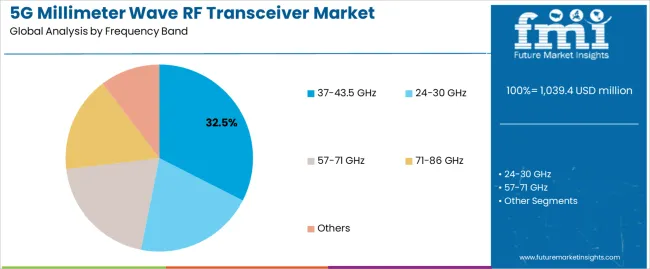
The 37-43.5 GHz frequency band segment is projected to account for 32.5% of the 5G millimeter wave RF transceiver market in 2025, reaffirming its position as the leading frequency category. Telecommunications operators and infrastructure providers increasingly utilize mid-band millimeter wave RF transceivers for their superior coverage balance capabilities when operating across diverse deployment scenarios, excellent signal propagation characteristics, and cost-effectiveness in applications ranging from urban network deployment to suburban coverage extension. Mid-band millimeter wave RF transceiver technology's advanced signal processing capabilities and optimized range performance directly address the network requirements for comprehensive coverage in mixed-density environments.
This frequency segment forms the foundation of modern 5G network deployments, as it represents the transceiver type with the greatest deployment flexibility and established market demand across multiple application categories and network scenarios. Manufacturer investments in enhanced power efficiency technologies and beamforming compatibility continue to strengthen adoption among telecommunications operators and equipment manufacturers. With companies prioritizing network performance and coverage optimization, mid-band millimeter wave RF transceivers align with both technical requirements and economic efficiency objectives, making them the central component of comprehensive 5G infrastructure strategies.
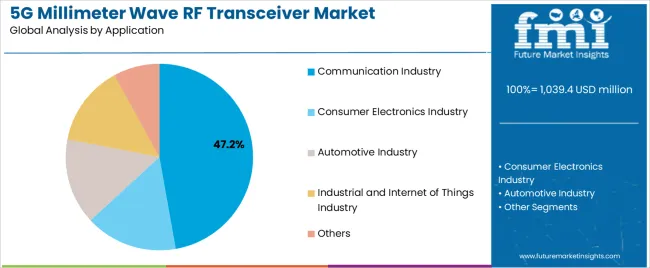
Communication industry applications are projected to represent 47.2% of 5G millimeter wave RF transceiver demand in 2025, underscoring their critical role as the primary telecommunications consumers of advanced millimeter wave technology for network infrastructure, base station deployment, and wireless communication enhancement applications. Network operators prefer 5G millimeter wave RF transceivers for their exceptional data transmission capabilities, ultra-low latency characteristics, and ability to support massive connectivity while ensuring effective network performance throughout diverse deployment scenarios. Positioned as essential components for modern telecommunications infrastructure, 5G millimeter wave RF transceivers offer both performance advantages and operational efficiency benefits.
The segment is supported by continuous innovation in beamforming technologies and the growing availability of specialized communication systems that enable variable power management with enhanced coverage uniformity and rapid data processing capabilities. Additionally, telecommunications operators are investing in network modernization systems to support large-scale 5G deployment and infrastructure optimization. As next-generation connectivity demand becomes more prevalent and network performance requirements increase, communication industry applications will continue to dominate the end-use market while supporting advanced telecommunications infrastructure utilization and wireless network enhancement strategies.
The 5G millimeter wave RF transceiver market is advancing rapidly due to increasing demand for high-speed wireless communication technologies and growing adoption of advanced 5G infrastructure solutions that provide superior data transmission rates and connectivity efficiency while enabling reduced latency across diverse telecommunications and industrial automation applications. However, the 5G millimeter wave RF transceiver market faces challenges, including high deployment costs, limited signal propagation range, and the need for specialized installation and maintenance expertise. Innovation in beamforming capabilities and ai-powered signal processing systems continues to influence product development and market expansion patterns.
The growing adoption of advanced beamforming systems, multiple-input multiple-output (MIMO) architectures, and intelligent antenna arrays is enabling manufacturers to produce sophisticated 5G millimeter wave RF transceivers with superior directional control capabilities, enhanced spatial diversity performance, and automated signal optimization functionalities. Advanced beamforming systems provide improved signal quality while allowing more efficient spectrum utilization and consistent performance across various deployment conditions and interference scenarios. Manufacturers are increasingly recognizing the competitive advantages of beamforming capabilities for network differentiation and premium market positioning.
Modern 5G millimeter wave RF transceiver producers are incorporating artificial intelligence algorithms, machine learning-based optimization systems, and intelligent signal processing capabilities to enhance network performance, enable predictive maintenance functionalities, and deliver value-added solutions to telecommunications customers. These technologies improve network efficiency while enabling new operational capabilities, including real-time interference mitigation, adaptive power management, and reduced operational complexity. Advanced AI integration also allows manufacturers to support comprehensive network management systems and telecommunications modernization beyond traditional manual optimization approaches.
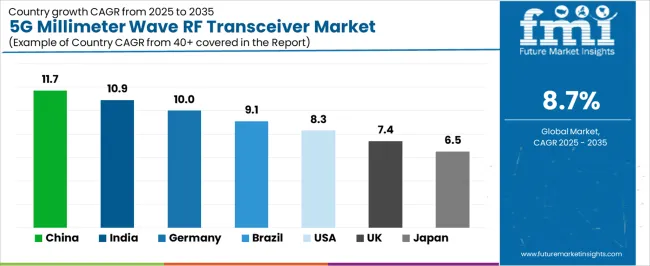
| Country | CAGR (2025–2035) |
|---|---|
| China | 11.7% |
| India | 10.9% |
| Germany | 10.0% |
| Brazil | 9.1% |
| United States (USA) | 8.3% |
| United Kingdom (UK) | 7.4% |
| Japan | 6.5% |
The 5G millimeter wave RF transceiver market is experiencing strong growth globally, with China leading at an 11.7% CAGR through 2035, driven by the expanding 5G infrastructure development programs, growing wireless communication adoption, and significant investment in telecommunications technology advancement. India follows at 10.9%, supported by government initiatives promoting digital infrastructure, increasing telecommunications modernization demand, and growing connectivity requirements. Germany shows growth at 10.0%, emphasizing advanced telecommunications innovation and high-tech communication technology development. Brazil records 9.1%, focusing on telecommunications infrastructure expansion and network modernization programs. The USA demonstrates 8.3% growth, prioritizing wireless communication excellence and network infrastructure advancement. The UK exhibits 7.4% growth, emphasizing telecommunications technology adoption and wireless infrastructure development. Japan shows 6.5% growth, supported by advanced technology initiatives and high-precision communication concentration.
The report covers an in-depth analysis of 40+ countries; seven top-performing countries are highlighted below.
Revenue from 5G millimeter wave RF transceivers in China is projected to exhibit exceptional growth with a CAGR of 11.7% through 2035, driven by expanding 5G network deployment programs and rapidly growing telecommunications infrastructure adoption supported by government initiatives promoting advanced communication technology development. The country's strong position in electronics manufacturing and increasing investment in next-generation wireless infrastructure are creating substantial demand for advanced 5G millimeter wave RF transceiver solutions. Major telecommunications operators and equipment manufacturers are establishing comprehensive production capabilities to serve both domestic network deployment demand and international telecommunications markets.
Revenue from 5G millimeter wave RF transceivers in India is expanding at a CAGR of 10.9%, supported by the country's massive telecommunications sector, expanding government support for digital infrastructure modernization, and increasing adoption of advanced wireless communication solutions. The country's initiatives promoting telecommunications technology and growing network operator awareness are driving requirements for enhanced connectivity capabilities. International suppliers and domestic manufacturers are establishing extensive production and service capabilities to address the growing demand for millimeter wave RF transceiver products.
Revenue from 5G millimeter wave RF transceivers in Germany is expanding at a CAGR of 10.0%, supported by the country's advanced telecommunications capabilities, strong emphasis on communication technology innovation, and robust demand for high-performance wireless infrastructure in network deployment and industrial automation applications. The nation's mature telecommunications sector and efficiency-focused operations are driving sophisticated 5G millimeter wave RF transceiver systems throughout the communications industry. Leading manufacturers and technology providers are investing extensively in beamforming systems and advanced signal processing technologies to serve both domestic and international markets.
Revenue from 5G millimeter wave RF transceivers in Brazil is growing at a CAGR of 9.1%, driven by the country's expanding telecommunications sector, growing network infrastructure development, and increasing investment in wireless technology advancement. Brazil's large telecommunications market and commitment to digital modernization are supporting demand for efficient 5G millimeter wave RF transceiver solutions across multiple network deployment segments. Manufacturers are establishing comprehensive service capabilities to serve the growing domestic market and regional telecommunications opportunities.
Revenue from 5G millimeter wave RF transceivers in the USA is expanding at a CAGR of 8.3%, supported by the country's advanced telecommunications technology sector, strategic focus on wireless communication efficiency, and established next-generation network capabilities. The USA's telecommunications innovation leadership and technology integration are driving demand for 5G millimeter wave RF transceivers in commercial network deployment, enterprise communications, and advanced infrastructure applications. Manufacturers are investing in comprehensive technology development to serve both domestic telecommunications markets and international specialty applications.
Revenue from 5G millimeter wave RF transceivers in the UK is growing at a CAGR of 7.4%, driven by the country's focus on telecommunications technology advancement, emphasis on wireless communication efficiency, and strong position in network infrastructure development. The UK's established telecommunications innovation capabilities and commitment to digital modernization are supporting investment in advanced millimeter wave technologies throughout major metropolitan regions. Industry leaders are establishing comprehensive technology integration systems to serve domestic network operations and specialized telecommunications applications.
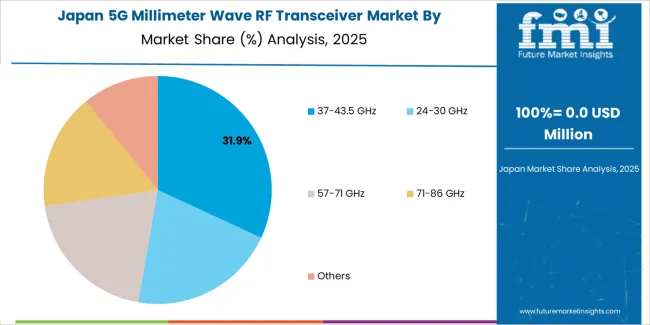
Revenue from 5G millimeter wave RF transceivers in Japan is expanding at a CAGR of 6.5%, supported by the country's high-tech communication initiatives, growing advanced wireless sector, and strategic emphasis on telecommunications automation development. Japan's advanced technology capabilities and integrated communication systems are driving demand for sophisticated 5G millimeter wave RF transceivers in precision network deployment, advanced telecommunications, and high-performance wireless applications. Leading manufacturers are investing in specialized capabilities to serve the stringent requirements of high-tech communications and advanced network industries.
The 5G millimeter wave RF transceiver market in Europe is projected to grow from USD 187.1 million in 2025 to USD 430.7 million by 2035, registering a CAGR of 8.7% over the forecast period. Germany is expected to maintain its leadership position with a 38.4% market share in 2025, declining slightly to 37.9% by 2035, supported by its strong telecommunications infrastructure sector, advanced communication technology capabilities, and comprehensive wireless automation industry serving diverse 5G millimeter wave RF transceiver applications across Europe.
France follows with a 19.7% share in 2025, projected to reach 20.2% by 2035, driven by robust demand for 5G millimeter wave RF transceivers in telecommunications modernization, network infrastructure programs, and advanced wireless applications, combined with established technology infrastructure and specialty communication expertise. The United Kingdom holds a 16.2% share in 2025, expected to reach 16.7% by 2035, supported by strong telecommunications technology sector and growing advanced network activities. Italy commands a 11.8% share in 2025, projected to reach 12.1% by 2035, while Spain accounts for 8.4% in 2025, expected to reach 8.7% by 2035. The Netherlands maintains a 3.7% share in 2025, growing to 3.8% by 2035. The Rest of Europe region, including Nordic countries, Eastern Europe, Belgium, Poland, and other nations, is anticipated to maintain momentum, with its collective share moving from 1.8% to 0.6% by 2035, attributed to increasing telecommunications modernization in Eastern Europe and growing wireless infrastructure penetration in Nordic countries implementing advanced communication technology programs.
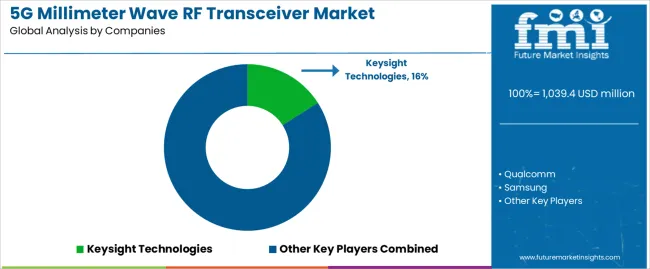
The 5G millimeter wave RF transceiver market is characterized by competition among established semiconductor manufacturers, specialized RF technology producers, and integrated wireless communication solutions providers. Companies are investing in beamforming technology research, signal processing optimization, advanced antenna system development, and comprehensive product portfolios to deliver consistent, high-performance, and application-specific 5G millimeter wave RF transceiver solutions. Innovation in ai-powered systems, MIMO integration, and operational efficiency enhancement is central to strengthening market position and competitive advantage.
Keysight Technologies leads the 5G millimeter wave RF transceiver market with a strong market share, offering comprehensive 5G millimeter wave RF transceiver solutions including advanced measurement systems with a focus on telecommunications and industrial applications. Qualcomm provides specialized wireless communication capabilities with an emphasis on mobile platform integration and automated connectivity systems. Samsung delivers innovative semiconductor products with a focus on high-performance platforms and commercial telecommunications services. Intel specializes in wireless technology automation and 5G millimeter wave RF transceiver technologies for large-scale network applications. Analog Devices focuses on precision signal processing equipment and integrated communication solutions. Texas Instruments offers specialized semiconductor platforms with emphasis on industrial and automotive applications.
| Item | Value |
|---|---|
| Quantitative Units | USD 1,039.4 million |
| Frequency Bands | 24–30 GHz, 37–43.5 GHz, 57–71 GHz, 71–86 GHz, Others |
| Applications | Communication Industry; Consumer Electronics Industry; Automotive Industry; Industrial & Internet of Things Industry; Others |
| Technology Types | Beamforming Systems; MIMO Platforms; Traditional RF Type Systems |
| End-Use Sectors | Telecommunications Operators; Equipment Manufacturers; Automotive Companies; Industrial Enterprises |
| Regions Covered | North America; Europe; East Asia; South Asia & Pacific; Latin America; Middle East & Africa |
| Key Countries | China; India; Germany; Brazil; United States; United Kingdom; Japan (+ 40 other countries) |
| Key Companies Profiled | Keysight Technologies; Qualcomm; Samsung; Intel; Analog Devices; Texas Instruments |
| Additional Attributes | Dollar sales by frequency band and application category; Regional demand trends; Competitive landscape; Technological advancements in beamforming systems & signal processing; AI integration innovation; Wireless infrastructure integration |
The global 5G millimeter wave RF transceiver market is estimated to be valued at USD 1,039.4 million in 2025.
The market size for the 5G millimeter wave RF transceiver market is projected to reach USD 2,393.7 million by 2035.
The 5G millimeter wave RF transceiver market is expected to grow at a 8.7% CAGR between 2025 and 2035.
The key product types in 5G millimeter wave RF transceiver market are 37-43.5 ghz, 24-30 ghz, 57-71 ghz, 71-86 ghz and others.
In terms of application, communication industry segment to command 47.2% share in the 5G millimeter wave RF transceiver market in 2025.






Full Research Suite comprises of:
Market outlook & trends analysis
Interviews & case studies
Strategic recommendations
Vendor profiles & capabilities analysis
5-year forecasts
8 regions and 60+ country-level data splits
Market segment data splits
12 months of continuous data updates
DELIVERED AS:
PDF EXCEL ONLINE
5G Testing Market Size and Share Forecast Outlook 2025 to 2035
5G in Healthcare Market Analysis Size and Share Forecast Outlook 2025 to 2035
5G Temperature-Compensated Crystal Oscillator (TCXO) Market Size and Share Forecast Outlook 2025 to 2035
5G Remote Surgery System Market Analysis - Size, Share, and Forecast Outlook 2025 to 2035
5G Telemedicine Platform Market Size and Share Forecast Outlook 2025 to 2035
5G Industrial IOT Market Size and Share Forecast Outlook 2025 to 2035
5G IoT Market Size and Share Forecast Outlook 2025 to 2035
5G in Defense Market Size and Share Forecast Outlook 2025 to 2035
5G Enterprise Private Network Market Size and Share Forecast Outlook 2025 to 2035
5G Edge Cloud Network and Services Market Size and Share Forecast Outlook 2025 to 2035
5G Automotive Grade Product Market Size and Share Forecast Outlook 2025 to 2035
5G Enterprise Market Size and Share Forecast Outlook 2025 to 2035
5G Infrastructure Market Size and Share Forecast Outlook 2025 to 2035
5G RAN Market Size and Share Forecast Outlook 2025 to 2035
5G Security Market Size and Share Forecast Outlook 2025 to 2035
5G Testing Equipment Market Analysis - Size, Growth, and Forecast 2025 to 2035
5G technology market Analysis by Technology Type, Application, Vertical, and Region – Growth, trends and forecast from 2025 to 2035
5G in Automotive and Smart Transportation Market by Solution ,Application,Industry , Warehousing & Logistics, Warehousing & Logistics, Public Safety and Others & Region Forecast till 2025 to 2035
5G System Integration Market Insights - Demand & Growth Forecast 2025 to 2035
5G Chipset Market Analysis - Growth & Forecast through 2034

Thank you!
You will receive an email from our Business Development Manager. Please be sure to check your SPAM/JUNK folder too.
Chat With
MaRIA